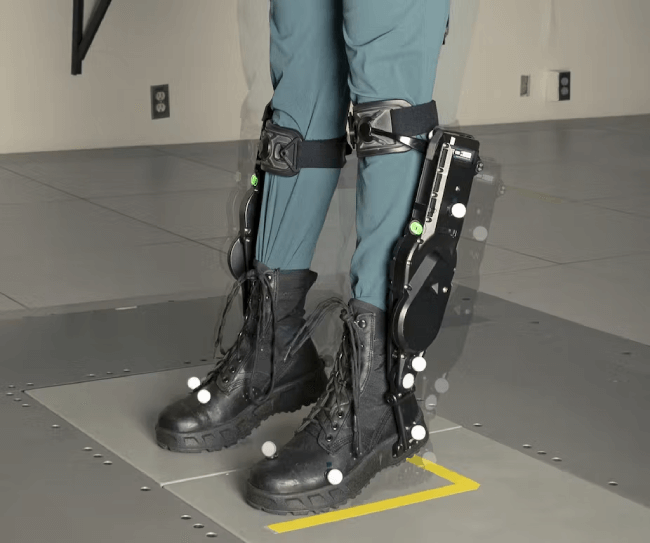Researchers Discover Surprising Insights into Human Reflexes with Exosuit Boots
01-03-2023 | By Robin Mitchell
Augmented systems, such as exosuits or powered suits, can help improve balance and motion, but they also present challenges. Researchers have found that these systems must be able to react faster than the human body in order to effectively improve balance. This discovery could potentially help in the development of future augmentation systems, including those aimed at improving prosthetics or helping those who need assistance with mobility. What challenges do augmented systems present, what did the researchers discover, and how would this translate to future augmentation systems?
What challenges do augmented systems present?
Despite decades of science fiction depicting augmentation suits able to provide immense capabilities to users, they are still mostly science fiction. While some researchers have managed to develop basic suits, they often suffer from limited capabilities, require a constant connection to a jig, or are too heavy to use. Even simpler systems like those demonstrated in Aliens (Signory Weaver) are still science fiction.
The reason why such mechanised systems are still fantasy primarily comes down to complexity. Creating robotic arms is relatively easy and has been done for decades. Creating an arm-worn device that can track movement and translate this movement to control a robotic arm is also trivial. But, developing a robotic arm that surrounds a human operator and flawlessly moves with the arm is extremely difficult.
To start, the robotic system must be able to detect the slightest movements from the human arm, and detecting minute changes in movement is challenging. At the same time, detecting minute changes must be done accurately; otherwise, the robotic system may react erratically. This also becomes challenging when considering that it is possible to get into a positive feedback loop where the movement of the robotic arm changes the position of the human arm, which in turn, gets translated into a movement request.
To get around this, it is possible to measure the electric potentials of nerves to try and understand what the human intention is. For example, if a robotic arm is tied to the nerves in an arm, only conscious decisions to move the arm will result in the robotic arm moving. If the human arm is moved without nerve control (i.e., via the robotic arm), the new position will not be registered as a move command, hence killing the positive feedback loop.
But trying to read the state of nerves and translate the electric signals to fine motor controls of a robotic arm is a tremendous task. The human body contains trillions of nerves, all of which are connected to millions of muscle fibres and other body parts. Detecting these signals and understanding their purpose is a computationally monumental task.
Researchers develop balancing boots and discover that nerves are slow
Recently, researchers from Georgia Tech and Emory developed a pair of exosuit boots that have been designed to provide additional balance. For example, if a slippery floor is encountered, the boots will be able to reduce the chances of falling by counteracting unstable movements.
To test the boots, the researchers created a motorised floor that quickly pitched users towards the ground to test out the capabilities of the boots. However, the boots failed to provide any additional balance in the first two experiments, where the first test involved no help from the boot at all and then assistance from the boot after the wearers started to move. But, when the researchers configured the boots to act faster than the wearers (i.e., faster reaction times), the boots were able to prevent falling. As such, the researchers concluded that if future exosuits are to be successful, they will need to have reaction times faster than people, essentially requiring them to anticipate movement.
At the same time, the researchers also used ultrasound sensors to observe the calf muscles of those using the boots. According to the researchers, when the boots reacted faster than the users, the nerves responsible for controlling the calf muscles never activated, but the control signals responsible for generating a response to the sudden imbalance persisted. This revelation suggests that reflexes are more complex than initially thought, with nerves combining information about their surroundings before deciding to act.

Candler Hobbs, Georgia Institute of Technology
How do these findings translate to future augmented systems?
What the researchers have discovered here is that in order for future augmentation systems to be practical, they may be required to anticipate human movement to some degree, certainly for reflex and balancing. As such, a future suit would likely have two modes of operation; fine motor control and balancing. Fine motor control would be able to utilise human motion to perform delicate tasks, such as picking up objects and working with tools, while balancing modes would require the augmentation system to operate independently from the user.
Of course, this only applies to augmentation systems that are being used to prevent falling and doesn’t include systems that may only provide additional strength. In these applications, users would be solely responsible for augmented motion, and this could leave them vulnerable to sudden actions such as falling and catching. But even in those cases, the challenges discussed before still apply, and future augmented systems would require immense data processing capabilities to read and isolate individual nerve commands.

